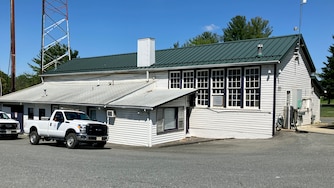The whistle blared for adult swim at Pine Valley, and parents sprang into action.
As kids climbed out of the Rosedale pool, nagged by the two life guards on duty, moms — who had been sitting next to their Bogg bags or reading their well-loved paperbacks — slid from the pool deck into the water.
For the next 15 minutes or so, before the whistle would blow and restore the chaos of a midsummer pool day, the moms waded in a circle, laughing, catching up and discussing the plans for the rest of the season.
This is, in many ways, exemplary of Baltimore County’s semi-exclusive pool culture. Yes, you go to the pool so the kids have somewhere to hang out over the summer and stay active. But you also join — if you’re able to— for the chance to be seen and be part of a select community.
And select it is. There are hundreds of pools in the county, and not one is open to the public daily.
There are some exceptions — Pine Valley has a community day each week, anyone can purchase a day pass at Cockeysville’s Beaver Dam Swimming Club, and the county government has partnerships for limited paid pool access at YMCAs in Dundalk and Randallstown. A community college has opened up its indoor pool for some public access recently, too.
But, otherwise, from the sprawling Padonia swim club in Cockeysville to smaller neighborhood pools like Eastcrest in Dundalk, pools in Baltimore County require an often expensive membership. A weekdays-only membership for a family of 4 at Padonia, for example, was $1,150 for new members this year, or $1,700 for returning members.
A two-person “associate” membership at Springdale Swim Club in Cockeysville was $770 for 2025 (and requires approval from the club’s board). A family membership at Beaver Dam Swimming Club in Timonium started at $965 — and requires an additional “capital contribution” from new members. Many pools around the county have wait lists to join, because they limit membership slots.
In sharp contrast, Baltimore City‘s municipal pools don’t require anything other than a free online account.
The complete lack of municipal pools in the county is intimately linked to historical segregation.
It is also part of a broader “suburban phenomenon,” said Howard Means, the author of “Splash! 10,000 Years of Swimming.”
“The whole suburban culture became not quite private, but associative in a way, with where you lived,” he said.
Worth the cost?
Melissa Parker and her family used to be members at Padonia, but it became too expensive. Last summer, she got a membership for the Towson Merritt, because it’s much more affordable for her and her four children.
Compared to Padonia’s cost for a summer, a membership pass to the Towson Merritt can be less than $100 a month.
There certainly is a pool culture in Baltimore County, Parker said.
“Most of the families we know belong to a pool,” she said. “It’s definitely a summer thing here.”
Parker said she doesn’t think the relative exclusivity of some pools is intentionally “snobby.” People choose a pool based on where they live or who they know, she said.
And there are big differences between what Parker and her family could do at Padonia versus how they spend time at the Merritt pool.
“We had friends and family that belonged to that pool,” she said. “At the community pools, there are grills, playgrounds, they just have more amenities.”
While the pool at the Towson Merritt is large — and even has water slides — it doesn’t have grills, or a bar or the large amount of play space found at Padonia and other swim clubs.
A person in Baltimore County could go to a community pool and spend the full day there, Parker said — but that’s not as common or realistic a scenario at the gym pool.
“What we lose there is the community aspect,” she said.
The cost-benefit analysis required for joining a pool in the county is not new. About a decade ago, Pete Fitzpatrick considered a pool membership for his family in Catonsville, in southwest Baltimore County.
For the pools closest to where his family lived, the costs far exceeded the value, he said — and that’s on top of what he remembered as a two-year waitlist for full membership.
It would have been more than $1,000 per summer for his family, he said. But he and his wife both work, he explained, so they wouldn’t have time to take their kids to the pool every day.
“If you’re not using the pool like, a lot‚” Fitzpatrick said, “it’s not necessarily worth it.”
A third space
Even on a dreary weekday, there’s a frenetic energy at Springlake Swim Club. Swim practice just ended (the team name? Piranhas. Their motto? “We bite back!”) and more natural rhythms are returning to the pool.
As the kids splash in and out of the water, or climb a stepladder to order from a snack bar, parents relax and catch up.
“These places [community pools] are particularly joyful and precious, you just can’t compare it,” said Hannah S. Palmer, the author of “The Pool is Closed: Segregation, Summertime, and the Search for a Place to Swim,” a book about the history of segregated swimming.
At Springlake, at a table on the lawn, two or three parents chat between interruptions from kids running up to ask questions or get money for the snack bar.
It’s undeniably communal. Kids run to grown-ups who are not their own to ask where their parents went; parents ask each others’ kids to find one another or relay messages.
“It’s kind of like that third space,” said Julie Saxenmeyer, a Baltimore County native and member of Dulaney Swim Club in Timonium. “It’s somewhere to go ... just kind of sit and read, and get some fresh air.”

Though Padonia is expensive — prohibitively so, for some — it manages to be more accessible than some other pools in Baltimore County. That’s because there’s no waitlist to join, no need to purchase a bond and no requirement to have a recommendation from an existing member. The club runs specials on membership, too — for young professionals, people who purchase memberships early, older adults and more.
“It gives people options,” said Matt Musgrove, who owns the club. “We’re also aggressive in bringing in new members.”
Girume Ashenafi and Cassandra Chavez, who live in Timonium, joined Padonia earlier this summer so their 2-year-old son could become comfortable in the water. Another swim club closer to where they live charged a flat rate and also had a fee for kids; at Padonia, kids under 3 are free, and they chose a weekend membership to keep costs down.
“Summer Saturdays, like this one, we like to take him out,” Ashenafi said as his son napped on his wife’s shoulder.
Ashenafi said he’s never felt uncomfortable at the club. Parents of young children form community at the toddler pool, which is gated, and throughout the facility, people are friendly.
Parents will bring pool toys and beach balls for their kids, Ashenafi said, and it’s “very communal” in the sense that everyone shares. If someone accidentally brings a toy home that belongs to another family, there’s no drama — it’s just brought back next time.
“Come one, come all, play with anything,” he said. “It’s very communal in that sense.”
Families at Padonia move around the pool as they grow. They start where Ashenafi and Chavez lounged, then move to the larger wading pool with the slides. If they become serious about lap swimming, they may cross the patio to the Phelps Legacy Pool, or choose to enjoy full sun in the adult area without umbrellas.
“I’ve been here almost 25 years, and you almost see it generationally,” said Vivian Kipperman of Sparks. “The kids get older, and they leave, and come back. Everyone finds their place here.”
The Banner’s Rona Kobell contributed to this article.






Comments
Welcome to The Banner's subscriber-only commenting community. Please review our community guidelines.